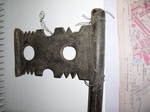Feather band
A sort of HATBAND, presumably one designed to hold decorative FEATHERs, and fashionable in the seventeenth century as shown, for example, in the picture of the Gunpowder Plot Conspirators painted in 1605 by an unknown artist, and that of the Squire of Alsatia painted in1688 by Laroon [Cumming (1984, reprint 1987)]. The one example found in the Dictionary Archive is dated the same year as the Gunpowder Plot [Inventories (1605)].
Not found in the OED
Sources: Inventories (early). References: Cumming (1984, reprinted 1987).
Felt [ffelt; felte]
A TEXTILE made from WOOL or mixed fibres compressed, rolled or fulled to bind them together. Either FELT WOOL, of which there were many types, was used, or the fur from the BEAVER SKIN, CONY SKIN or RABBIT SKIN.
Felt was used mainly to make FELT HATs, and by association the term indicated both hats made of felt and, on occasion, hats in general. Many of the terms that might be expected as descriptors for felt hat are found in association with felts. Some of these denote the WOOL from which the hat was made, hence 'estridge womens felts' made from ESTRIDGE WOOL [Inventories (1604)], 'Spanish or Portingale felts' made from SPANISH FELT WOOL [Rates (1582)], or 'pollonian feltes' made of POLONIA WOOL [Inventories (1604)].
OED earliest date of use c1000 as a fabric; c1450 as a hat
Found described as with BANDs, without bands, brayed, COARSE, COLOURED, DUTCH, DYED, FINE, FRENCH, NEW, pollonian, PORTUGAL, SMALL, SPANISH, lined with TAFFETA, undyed, unlined, untrimmed, lined with VELVET, WHITE, WOOL Found made in sizes or styles suitable for BOY, CHILDREN, GIRL, MEN, WOMEN, YOUTHFound in units of DOZEN Found rated by the DOZEN
See also FELT WOOL, HAT, RABBIT FUR. Sources: Acts, Diaries, Houghton, Inventories (early), Inventories (mid-period), Inventories (late), Patents, Tradecards.
Felt cloak [felt cloke; cloakes of felt]
In the late-sixteenth century and the early seventeenth, CLOAKs made of FELT became fashionable. Both the cloaks themselves and pieces of felt of the appropriate size were apparently imported from FRANCE, where the making of FELT HATs had first been established. The entry in the Book of Rates of 1660 went into some detail, describing such felt pieces as 'for Cloaks, French-making, three yards and an half long, one yard and an half broad the felt' [Rates (1660)].
OED online earliest date of use: 1599
Found in units of PIECESources: Rates.
Felt hat [ffelt hatt; felte hatte; felte hatt; felte hat; felt or wool stuff or beaver hat; felt or beaver stuff hats; felt hatt]
The term was often abbreviated to FELT. HATs made of FELT seem to have been developed as a manufacture in Normandy in the mid-fifteenth century from whence they were introduced into London. Their manufacture spread rapidly throughout England with an important centre just north of Bristol. Making felt hats required special short-fibred carding wool, sometimes called FELT WOOL. Much of this was imported from Spain and Portugal (SPANISH FELT WOOL), and later from Austria (ESTRIDGE WOOL) and Poland (POLONIA WOOL). Their manufacture involved several processes: carding, basining, felting, dressing, pouncing or pounding, blocking and dyeing. By 1609 the BEAVER HAT or CASTOR had been introduced using BEAVER WOOL. Towards the end of the seventeenth century, the Huguenots of Wandsworth (SW London) introduced yet another type called the Caudebac hat after the place they came from near Rouen. These hats were made of a fine, waterproof felt using a mixture of fine vicuna wool and rabbit wool [Kerridge (1985)]. Often all types were lumped together regardless of origin as 'Felt or Wool, Stuff or Beaver Hats' [Acts (1784)].
Once the basic shape had been made, a felt hat could be LINED with fashionable SILK fabrics like SARSENET, TAFFETA or VELVET [Inventories (1598)], or left UNLINED, and decorated with a HATBAND.
OED earliest date of use: 1457
Found described by NEWFound in units of DOZEN, PIECE
Sources: Acts, Inventories (early), Newspapers, Patents. References: Kerridge (1985).
Felt wool
A type of short-staple WOOL, often imported, for making FELT, particularly for HATs, felt wool is not to be confused with WOOL FELL, which was often known as 'Fell wool'. Topsell (1607), cited by the OED, gave it as an alternative name for Feltriolana, which would seem to be a term with much the same meaning. Felt wools were imported from Spain and Portugal, hence SPANISH FELT WOOL, and later from Austria as ESTRIDGE WOOL and from POLAND as POLONIA WOOL [Kerridge (1985)].
OED online earliest date of use: 1609
Found imported and rated by the POCKET
Sources: Houghton, Rates. References: Kerridge (1985).
http://www.british-history.ac.uk/report.asp?compid=58768
Sunday, 31 August 2008
Subscribe to:
Post Comments (Atom)




2 comments:
If you want a counter google "StatCounter" sign up for free. There is a link to StatCounters on my blog also. Nice start to your blog. I read your post with the feltmakers list. It would be nice to have pictures, just me, I like to have pictures to look at. ;o)
Thanks mim, I have now worked out how to add photos and hope you are enjoying them, but not how to put them in the body of a post - the next challenge!
Post a Comment